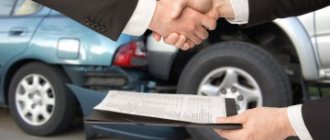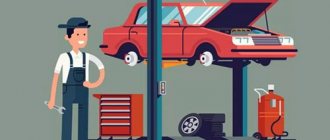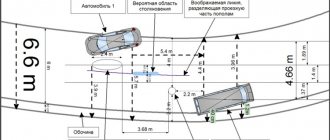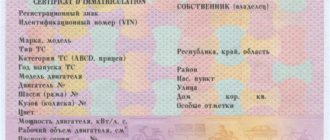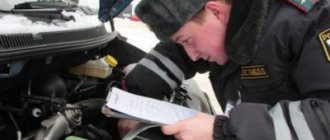Examination of the condition of vehicles is one of the types of automotive technical examination. The main objective of this study is to determine the presence of faults in a given car, or the absence thereof. The vehicle condition is analyzed in relation to the following parts:
- Engine
- Chassis
- Gear box
- Chassis
- Bumpers
- Electrical equipment of the car
- Suspension
- Other items
Most often, research is carried out in relation to the vehicle engine and determining its power. You can examine one or more components of a car, as well as analyze the technical condition of the entire vehicle as a whole.
Examination of the condition of vehicles is carried out in the following cases:
- Disputes related to consumer rights and their protection.
- Proceedings of road traffic accidents involving the vehicle under investigation.
When carrying out the research, the specialist conducting it uses the most modern analysis technologies in his work, which allows him to identify any malfunctions of the car, or make a conclusion about the absence of them. When malfunctions or defects in the car's components are detected, the expert analyzes the reasons for their occurrence - whether they are a manufacturing defect, a sign of wear and tear on parts, or arose as a result of improper operation of the car or deliberate damage to it.
If a manufacturing defect is detected, the expert determines the reasons for its occurrence, which may include the following:
- Lack of design model.
- Failure to comply with production technology.
- Use of lower quality materials in vehicle production.
- Worker mistakes when assembling a car.
- Other reasons.
The discovery of such defects, for which the manufacturer is to blame, is of particular importance during the warranty period. In this case, the malfunction must be eliminated by the manufacturing company or its representatives.
If the detected defects are the result of incorrect operation, the expert determines exactly what actions of the owner led to such destruction of the car elements.
It should be noted that the initiator of the examination (or his representative) has the right to be present during the inspection of the vehicle and the drawing up of an inspection and diagnostic report. In this case, the initiator of the study (or his representative) can draw the expert’s attention to those defects that the latter did not take into account.
Examination of the condition of vehicles is a labor-intensive study that requires the specialist performing it to have a high level of competence, extensive professional experience, as well as mastery of all modern research tools. Specialists of the Expert Center ANO have the necessary level of training, and also regularly undergo training and professional development courses. Expert center specialists also participate in conferences and seminars on the latest technologies for examining the condition of vehicles.
Checking the technical condition of the vehicle - features
Checking the technical condition of vehicles is carried out in all companies that have vehicles on their balance sheets. The management of the enterprise must take care of the existence of a mandatory procedure.
The check takes about fifteen to twenty minutes. It does not take place at service stations, but on site - that is, in a garage or in a company parking lot. There are two types of control. Let's look at each of them in more detail.
Pre-trip
This is an examination of the technical condition of the vehicle before sending the car on a flight. Manipulations are carried out before the equipment leaves the base. Upon completion of the diagnosis, the responsible person makes sure that the vehicle is fully operational and ready to hit the road.
Post-voyage
Another form of daily monitoring. Technological indicators and wear during operation (during long trips) are checked. Based on the results of this type of control, the technician sends the car to the parking lot or prescribes a more thorough diagnosis.
Daily vehicle maintenance
This is a preventive measure that allows you to identify problems in time and prevent serious breakdowns.
Daily vehicle maintenance.
When conducting monitoring, the employee responsible for the technical condition of the vehicle must pay attention to the following points:
- condition of the brake system;
- wear of axles, wheels and tires;
- integrity of the body part, headlights, wipers, glass;
- condition of pumps and generators, batteries, hydraulic parts;
- oil and fuel levels, no fluid leaks;
- filter condition.
You also need to monitor the cleanliness of the car and blow out the components in case of dust.
Who should issue waybills?
Let's start with the fact that every organization that has vehicles on its balance sheet must issue waybills.
This need has nothing to do with whether you provide services for transporting passengers and cargo or not. The obligation directly follows from clause 2 “Required details and procedure for filling out waybills” (Order of the Ministry of Transport of the Russian Federation dated September 18, 2008 No. 152). Let me remind you that a waybill is a document that serves as the basis for writing off consumed fuel and other fuels and lubricants. Only on the basis of this document will the tax office accept expenses.
Of course, in those organizations in which there is only one car on the balance sheet, and even that is used only by the manager, there is no need for detailed control over fuel consumption. Everything there is clear and transparent. But this is clear only to you, and not to the tax authorities. They will have to show who traveled, when and on what route. This is confirmation that the car is used in the affairs of the organization and is not driven for the personal needs of the manager.
Special attention should be paid to the consumption rate. It must be approved and the fuel consumption must correspond to it. This will prove that fuel consumption is being monitored and the driver is not draining anything from the tank. The norm can be calculated only by knowing the daily mileage. So you need to indicate it too. In general, once again confirm that the expenses incurred by the organization are aimed at making a profit.
Who carries out the control
The procedure has the right to be carried out by a full-time auto mechanic or a specialist hired under a contract. The first option implies a separate position in the enterprise. The director can send an existing mechanic for special training. In this case, it is important to ensure that the equipment necessary for control inspections is available.
In the second option, the company enters into an agreement with a service provider. The master comes to the garage as needed.
Requirements for a car going on a trip
Only a serviceable vehicle that has undergone repairs may be used.
Before setting off, you should pay attention to:
- smooth operation of brakes, gearbox, steering relay;
- clearly functioning battery;
- permissible tire pressure;
- serviceability of the clutch system, absence of extraneous noise when the vehicle is operating;
- horn signals, headlights;
- the presence in the body of a complete first aid kit, tools, fire extinguisher, jack;
- no oil or fuel leaks.
At his discretion, the consultant monitors other characteristics.
Requirements for the controller
A person with appropriate education can monitor the technical condition and equipment of vehicles. The required level is at least secondary specialized. According to regulations, a mechanic must have a certificate of conformity. After completing the training, the certificate is issued by the transport inspectorate.
Questions answered by a vehicle condition examination specialist
- What is the engine power of the car under study?
- Does the identified capacity correspond to the technical documentation?
- What are the reasons for the discrepancy between the actual power of the car and the technical characteristics stated in the passport?
- Did the research reveal any defects or malfunctions in the engine's operation?
- Are the car's electrical devices working properly?
- What is the cause of the malfunction of the electrical equipment of the vehicle under study? Is it a factory defect? The result of improper operation of the car? The result of deliberate damage to equipment?
- Is the gearbox OK? What are the reasons for its malfunction?
- What is the condition of the suspension?
- Is its malfunction a manufacturing defect?
- What are the operating features of the vehicle under study that led to the detected defects, breakdowns and malfunctions?
- Is the chassis of the vehicle being tested in good working order?
- Which parts of the chassis contain malfunctions and defects? What is the reason for their occurrence?
- What is the condition of the bumper of the car under study? What is the cause of the breakdown (defect, malfunction)?
- What changes to the car design were made by the customer? What consequences did they lead to?
- Are the detected defects and malfunctions the result of poor quality repairs?
- Are the detected defects the result of a makeshift modification of the vehicle?
- What is the condition of the chassis of the vehicle under study? Are deviations from the reference state due to assembly errors or manufacturing defects? Could these deviations be caused by incorrect operation of the vehicle?
Sample control procedure
The procedure for conducting inspections of the technical condition of vehicles is enshrined in the road safety instructions; recommendations can also be obtained from the Ministry of Transport.
The control plan includes a list of manipulations, the main ones look like this:
- study of the appearance of equipment;
- checking the body, driver's cabin, signals, lights, brakes, battery;
- control of the main systems: air suspension, steering, clutch, engine;
- checking axle parameters, integrity of hoses, turn signals;
- analysis of wheels, tires, bumpers.
Let us remind you that the driver is present when drawing up the inspection report.
Note that operational control can be carried out in a number of areas. Which way to go is decided by the person in charge. The amount of manipulation directly depends on the condition of the machine and its type. Let's consider the possible options in more detail.
Types and scope of checking the technical condition of a vehicle
Technical control is divided into visual and manual. The technician uses the second option if a specific part or system is suspicious. A diagnostic map using some diagrams - that is, bypassing the official expert opinion. Such “tricks” threaten the company with fines from the traffic police, and also increase the risk of accidents. Let's return to the “white” schemes.
Verification methods
Technical control (pre-shift and post-trip) is divided into a full inspection and monitoring of a specific system. A full inspection, required by orders of the Ministry of Transport, is designed to ensure road safety and control all components of the vehicle. Partial inspection is used when one of the systems breaks down or malfunctions. Let's look at the nuances in each machine system.
Brake systems
Checking the brake system.
Brakes are one of the main parts of the vehicle, responsible for the safety of the driver and others.
When inspecting them, the following problems may be revealed:
- reduced system efficiency;
- jamming, interruptions;
- fluid leak;
- failure of brake lights.
If the above is detected, the car is sent for a detailed examination.
Steering systems
Failures here can be like this:
- control jamming;
- violation of adjustment of parts.
The car is also sent to a repair station.
External lighting devices
When inspecting the headlights, a technician may find:
- contact closure;
- Malfunctions of the rear/front lights.
The vehicle is not allowed on the road until the situation is corrected.
Wheels and pneumatic tires
The fastening and external condition of the “shoes” of the vehicle are checked. If necessary, place the car on a jack and tighten the nuts. Rubber damage, bumps, different tread patterns, and worn tires are unacceptable.
Engine and its systems
The engine is the “heart” of the car. Its operation is checked at full and low speed, as well as at idle. An increased concentration of smoke, its entry into the driver’s cabin, and clutch failure are reasons to send the equipment to the station.
Other structural elements
The mounting of the tractor with the semi-trailer, stable mounting of mirrors, canopies and license plates are subject to detailed inspection.
The mechanic also rules out deep dents, damage to the platform, and cracked headlights. If the inspection reveals the above, the parts that have become unusable are replaced and the fastenings are adjusted.
Verification Tools
For full maintenance in the garage, organizations must have:
- several types of jacks (for each type of equipment);
- pressure gauge for checking wheels and tire pressure;
- hammer with a long handle;
- sets of tools (wrenches, nuts).
In large companies, it is advisable to supply equipment for computer diagnostics.
Schedule
The frequency of inspections is fixed in the Regulations on Road Traffic Safety, and the inspection plan is also described there.
The technician inspects the machines before each trip to the line. Otherwise, all participants (driver, company, controller) receive penalties.
Documenting results
Documenting the results.
The monitoring results are recorded in the logbook. A sample document can be found in the public domain.
An example of the required graphs is:
- make and model (truck, passenger) of the vehicle;
- state number of the car;
- brief information about the driver;
- inspector data;
- time/date of recording the technical condition;
- odometer data, mileage;
- a note about passing a technical inspection;
- signatures of the inspector and the driver.
Also, the results of the inspection are included in the “travel book”.
Inspection of the vehicle while on the road
A control inspection of the vehicle on the road is carried out in order to prevent and timely eliminate any identified faults.
Usually, on the way, the technical condition of the car is checked according to the readings of instrumentation and a thorough inspection of the car at rest stops.
A control inspection is carried out immediately after stopping the car. In this case, the following volume and sequence of work is recommended.
1.'Check by touch; degree of heating of wheel hubs and brake drums, cardan joints, gearbox housings (divider), transfer case and drive axles. In this case, heating is considered normal if it does not cause a burning sensation in the palm of the hand.
2. If necessary, remove dirt and snow from license plates and identification plates, rear lamp glass with sidelights, side lights, windshields and cab door glass.
3. Make sure there are no leaks of oil, fuel, coolant, brake and shock absorber fluids.
4. Check the oil level in the engine crankcase, coolant in the radiator and fuel in the tank.
5. Check the presence and tightness of the wheel nuts, the condition of the tires, springs, the fastening of the shock absorbers, the condition and presence of cotter pins in the connections of the steering and brake drive rods, the amount of air pressure in the wheel tires (if necessary, bring it to normal).
6. Make sure that the brake light and rear light are in working order, and also check the fastening of the side locks and the serviceability of the towing device, the securing of the cargo and the technical condition of the trailer.
Malfunctions detected by the control inspection must be eliminated independently or with the assistance of technical assistance.
conclusions
Monitoring the technical condition of vehicles is a mandatory requirement for the carrier. A certified mechanic is responsible for the inspection. Control is carried out on the territory of the organization, its data is entered into the accounting books. Inspections must be carried out before each vehicle is put on the road.
The mechanic has the right to carry out full or partial control, manual or limited to visual. However, you need to remember that if the driver violates traffic rules or gets into an accident, not only the driver, but also the technician will be responsible for the incident.
A mark indicating a successful inspection is also placed in the travel document. Documents should be kept in archives for at least five years. For violation of inspection regulations, inspection authorities have the right to apply penalties. The company will have to pay up to thirty thousand rubles to the state treasury.
Detailed information is visible in the video:
Daily vehicle maintenance
Daily maintenance is the main type of car care. It is carried out after returning to the park in order to prepare the car for the upcoming trip. When performing daily maintenance, it is recommended to do the following: .
1. Upon returning the car from a trip, you must immediately check the heating of the wheel hubs, brake drums, gearbox housings (divider), transfer case, drive axles, and if increased heating is detected, find and eliminate the causes yourself or with the help of specialists at the technical point service.
2. By external inspection, make sure there is no damage to the body, cabin, doors, headlights, sidelights, rear lights, license plates, as well as leaks of fuel, oil, coolant, brake and shock absorber fluids, air leaks from the pneumatic system. Traces of leaks are easier to detect before washing the car on dusty units or components of the car. These marks are external signs of vehicle malfunctions that need to be detected and corrected.
3. Check the amount of fuel in the tank, the oil level in the engine crankcase and power steering reservoir, coolant in the radiator or expansion tank and top up to normal. It must be borne in mind that fuel tanks should be refueled without waiting for them to cool down; otherwise, water may condense, which will interfere with engine operation.
4. Clean the car from dirt, dust, snow, wash it if necessary, wipe the glass, tail, headlights, sidelights, license plates and identification plates. The undercarriage should be washed from below with a concentrated jet to knock off dried pieces of dirt, and the windows, cabin, hood, and wings should be washed with a dispersed jet. When washing the engine, do not allow water to come into contact with electrical equipment. The engine should only be washed with warm water under. light pressure and then thoroughly wipe the ignition system devices.
5. Check and, if necessary, adjust the tension of the fan, generator, and power steering pump drive belts. Weak belt tension causes engine overheating, undercharging of batteries, and reduced efficiency of the compressor and power steering pump.
6. If the car was operated in a very dusty area, then you should remove the engine and compressor air filters, disassemble them, wash their parts and change the oil, setting the required level.
7. Check the amount of play in the steering wheel (for vehicles with power steering, this operation should be performed with the engine running), the reliability of the attachment of the bipod, steering rods, brake drive and clutch pedal, drain the condensate from the air cylinders (drain only if there is air in the system ).
8. Check the condition and operation of the brakes, steering, lighting, alarm and windshield wipers.
9. Check the reliability of the batteries, wipe them from dust, check the connection of the wires at the terminals.
10. Check the condition of the cardan shafts, the fastening of their flanges and the condition of the springs, shock absorbers, and towing hitch.
11. Check the condition of the tires, the air pressure in the tires and the tightness of the wheel nuts.
12. Lubricate the components and mechanisms of the vehicle in accordance with the lubrication chart.
13. Check the presence, condition and installation of the winch cable, entrenching tool, driver’s tool, spare wheel, accessories, personnel equipment and off-road capabilities. If, when performing daily maintenance work, adjustment work or replacement of parts associated with disassembling the unit was carried out, then after completion of this work it is necessary to check the car in motion. 'During a short mileage of the car, the operation of the engine in all modes, the operation of the steering, and the efficiency of operation are checked. brakes, it is determined whether there are any extraneous knocks or increased noise.
When operating the vehicle in special conditions (mountainous areas, desert-sandy areas), additional work must be performed in accordance with the requirements of the maintenance instructions for these conditions.
